Understanding your hairline type is useful for choosing hairstyles that flatter your face shape, determining how to style your hair, and even identifying early signs of hair loss or thinning.
A proper understanding of different hairline types is essential for effectively applying hair extensions to achieve a natural and flattering look. Here's a detailed explanation:

-
Straight Hairline: Uniform across the forehead. Ideal for most types of hair extensions as there's an even base for application.
-
Rounded Hairline: Follows the curve of the head, softer around the temples. Extensions can be used to enhance volume while maintaining the natural curve.
-
Widow's Peak: A V-shape in the middle of the forehead. Care is needed with extensions to either accentuate the peak or to disguise it, depending on the desired look.
-
Bell-shaped Hairline: Wider in the middle and narrows at the sides. Extensions can be applied to create a more balanced look.
-
Uneven Hairline: Asymmetry can be corrected or camouflaged with strategic placement of extensions.
-
Receding Hairline: Extensions can be used to add volume to the front, but careful attention is needed to avoid stress on thinning hair.
-
High Hairline: Extensions can help in creating the illusion of a lower hairline if desired, especially with bangs or fringe extensions.
-
Low Hairline: Extensions are usually focused on adding volume or length rather than altering the hairline.
-
M-shaped Hairline: Can be challenging; extensions need to be placed to create a more uniform hairline appearance.
-
Cowlicks and Baby Hairs: Require careful placement of extensions to ensure a natural look while accommodating the direction of hair growth.

Hairline types in women are primarily characterized by their shape and position on the forehead.
-
Straight Hairline: This hairline runs straight across the forehead. It's the most uniform type of hairline and is often considered a "classic" look. A straight hairline can give a balanced appearance to the face.
-
Rounded Hairline: A rounded hairline follows the curve of the head and is more prominent around the temples. It softens the facial features and is often associated with a youthful appearance.
-
Widow's Peak: Characterized by a V-shape or a point in the middle of the forehead, a widow's peak can be subtle or pronounced. This type of hairline can give a distinctive look and is often a hereditary trait.
-
Bell-shaped Hairline: Resembling the shape of a bell, this hairline has a wider appearance in the middle of the forehead and narrows down at the sides. This type can add a gentle curvature to the face.
-
Uneven Hairline: Some women have an uneven or asymmetrical hairline, where one side may be higher or more receded than the other. This can be a natural variance or result from hair loss or breakage.
-
Receding Hairline: This is where the hairline starts moving backwards from the forehead. It's a common sign of hair thinning or hair loss in women and can be due to various factors like genetics, hormonal changes, or medical conditions.
-
High Hairline: A high hairline sits further up on the forehead, giving the appearance of a larger forehead. This is often a genetic trait and can influence how certain hairstyles look.
-
Low Hairline: Conversely, a low hairline sits closer to the eyebrows and gives the appearance of a smaller forehead. This type can make some hairstyles, like bangs, more challenging to pull off.
-
M-shaped Hairline: Also known as a "male-pattern" hairline in its more pronounced form, this type of hairline has a receding pattern at the temples. It's less common in women but can occur, especially with hormonal changes or hair loss conditions.
-
Cowlicks and Baby Hairs: While not hairlines per se, cowlicks (hair that grows in a different direction) and baby hairs (fine, short hairs) around the hairline can significantly influence its appearance and how hairstyles are managed.
Conclusion:
The application of hair extensions varies significantly based on the type of hairline, the health of the hair, and the desired outcome.
A thorough understanding of these factors ensures that the extensions enhance the natural beauty of the client without compromising hair health.
Always consider consulting with a professional hairstylist for the best results, especially for complex cases like receding or uneven hairlines
We would love to hear you comments on this subject
Thanks
Mel xx

